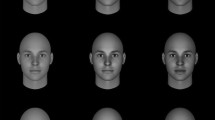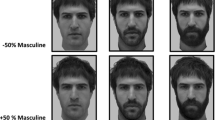Abstract
Archer et al. (1983) found that visual depictions (e.g., photographs) of men tend to show more face and less of the body (a characteristic that was termed high face-ism) than visual depictions of women. Furthermore, photographs (of both men and women) high in face-ism elicited more favorable impressions than photographs low in face-ism. The present studies examined possible reasons for sex differences in face-ism and their implications concerning the effects of high and low face-ism on interpersonal perception. Study 1 showed that the greater face-ism in photographs of men was less pronounced when the photographs were taken from periodicals that are oriented toward women's issues. Study 2 showed that photographs high in face-ism received higher ratings on dominance, a dimension related to masculinity, but not on positivity, a dimension related to femininity. This study also indicated that facial expressions provided more information about degrees of positivity while body cues provided more information about dominance and submission. Consistent with these latter results, Study 3 showed that amateur drawings portraying kind or hostile persons showed more of the face while drawings presenting dominant or weak persons showed more of the body. The two phenomena—the relationship of high face-ism with impressions of high dominance and the different types of information transmitted by the face and body—were considered in the discussion.
Similar content being viewed by others
References
Archer D., Iritani, B., Kimes, D.D., & Barrios, M. Face-ism: Five studies of sex differences in facial prominence.Journal of Personality and Social Psychology, 1983,45, 725–735.
Broverman, I.K., Vogel, S.R., Broverman, D.M., Clarkson, F.E., & Rosenkrantz, P.A. Sex-role stereotypes: A current appraisal.Journal of Social Issues, 1972,28, 59–78.
DePaulo, B.M. & Rosenthal, R. Ambivalence, discrepancy, and deception in nonverbal communication. In R. Rosenthal (Ed.),Skill in nonverbal communication. Cambridge, MA: Oelgeschlager, Gunn, & Hain, pp. 204–248. 1979.
Hall, J.A. Gender differences in nonverbal communication skills. In R. Rosenthal (Ed.),Quantitative assessment of reasearch domains. San Francisco: Jossey-Bass. 1980.
Parsons, T. The American family: Its relations to personality and to the social structure. In T. Parsons & R.F. Bales (Eds.),Family socialization and interaction process. New York: Free Press. 1955.
Rosenthal, R. Estimating effective reliabilities in studies that employ judges' ratings.Journal of Clinical Psychology, 1973,35, 656–666.
Rosenthal, R. Combining results of independent studies.Psychological Bulletin, 1978,85, 185–193.
Rosenthal, R. & Rubin, D.B. A single, general display of magnitude of experimental effect.Journal of Educational Psychology, 1982,74, 166–169.
Rosenthal, R. & Rosnow, R.L.Essentials of behavioral research: Methods and ata analysis. New York: McGraw-Hill. 1984.
Spence, J.T. & Helmreich, R.L.Masculinity and femininity: Their psychological dimensions, correlates, and antecedents. Austin: University of Texas Press, 1978.
Zuckerman, M., Amidon, M.D., Bishop, S.E., & Pomerantz, S.D. Face and tone of voice in the communication of deception.Journal of Personality and Social Psychology, 1982,43, 347–357.
Author information
Authors and Affiliations
Additional information
The author would like to express his appreciation to Diana R. Satin and BiancaMaria (Mia) Penati for their assistance with this project.
Rights and permissions
About this article
Cite this article
Zuckerman, M. On the meaning and implications of facial prominence. J Nonverbal Behav 10, 215–229 (1986). https://doi.org/10.1007/BF00987481
Issue Date:
DOI: https://doi.org/10.1007/BF00987481




